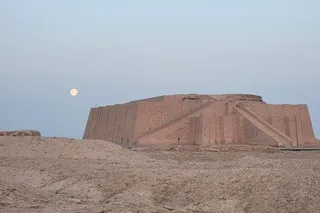Stonehenge is probably the world's most renowned henge – the name given to prehistoric stone or wooden circles. It's thought that the site's builders gathered close by at a settlement called Durrington Walls, which dates back to around 2500 B.C. Found around two miles from Stonehenge, archaeological studies have revealed what its inhabitants used to feast on.
Where's The Pork?
Researchers gleaned insights from a massive haul of animal bones found at Durrington Walls, explains Umberto Albarella, a zooarchaeologist with the University of Sheffield. Such studies have shed light on the behavior of the inhabitants of Durrington Walls — the presumed builders of Stonehenge — and are helping archaeologists reconstruct what their daily life may have looked like.
"The most remarkable thing is that most of the animal remains came from pigs," Albarella says, adding that pigs made up around 90 percent of the bones. Pork then was particularly plentiful and seemingly popular. Cattle provided another source of sustenance, while some evidence of the consumption of aurochs, an ancient wild ancestor of cows, was found.
It's pretty certain that the pigs and cattle were domestic animals, Albarella adds.
Read More: How Hunter-Gatherers Used The Land Around Stonehenge
Durrington Walls Was A Gathering Place
Researchers believe there was a permanent settlement at Durrington Walls, but it also drew in people from across the region for ceremonies and seasonal celebrations. Evidence shows that these travelers brought livestock with them from far and wide to provide meat for feasts.
"We can also envisage a situation in which it looks like there were big pig roasts," Albarella says. "There is also quite a lot of evidence of fires at the site." Furthermore, according to research, some of the pigs were killed at a young age, suggesting planned and seasonal consumption.
Read More: Stonehenge May Be an Ancient Solar Calendar
Last year, another study offered yet more evidence of eating habits at Durrington Walls, thanks to ancient parasites found in human and dog feces. These parasites – or coprolites – yielded clues that previous archaeological finds had not.
Analyzing preserved feces showed that "individuals had been eating the internal organs of the cattle," says Piers Mitchell, a professor at the Department of Archaeology at the University of Cambridge and lead author of the study. Given the presence of the parasites, the innards were probably undercooked. "They weren't just eating the steak bits… they were eating the whole lot."
Read More: Medieval Friars Were Filled With Worms
Durrington Walls Was Also A Meating Place
Curiously coprolites related to freshwater fish were found in one of the dog samples, but where they came from is uncertain. "Now that means that dog presumably ate some raw freshwater fish and then got infected," Mitchell says. Because some people were only at Stonehenge for short periods of time, it's possible that the dog in question ate it elsewhere, he continued, as there's no other evidence that the builders of Stonehenge consumed fish during their festivals.
While some evidence of the consumption of fruits and seeds – from apples, cherries and other wild fruits – was found at the site, it appears that the Durrington Walls peoples preferred meat. "There isn't much in terms of plants. So, it looks like it must have been quite a heavy meat diet," Albarella continues.
Albarella sees these kinds of studies as holding even more significance than just shedding light on Neolithic eating habits.
"There is so much evidence in the past, both in history and archaeology, of war and people fighting each other," he says, adding that Stonehenge and the site of Durrington Walls, however, were clearly sites where people came from far and wide to participate in rituals and feasts. "It's nice to see that we can reconstruct something that brought people together rather than against one another."















